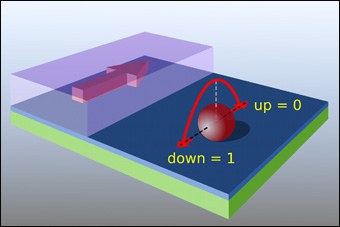Getting a new grip on nanomagnets
7 October 2013
A research team at the Peter Grünberg Institute (PGI-2) and the Institute for Advanced Simulation (IAS-3) has proposed a novel way of creating electrically-controllable nanomagnets, with several advantageous properties for information storage and for new nanoscale experiments. These so-called “spintronic nanomagnets” are generated by a new quantum mechanical effect. The theoretical physicists predict that the proximity to a ferromagnet generates a magnetic anisotropy barrier – a requisite for storing information in a nanomagnet – in material systems that usually do not support this.
The advantages of “spintronic magnetic anisotropy”, as the researchers named their effect, are many: in contrast to conventional nanomagnets, it can be generated in a broad class of materials and systems, it is electrically and magnetically tuneable, allowing for faster control, and the effect comes with a “spintronic magnetic field” that can be used to “read” or “write” information. Such tuning is not possible with conventional magnetic anisotropy, which requires a slow external magnetic field to control it. The research findings were published online on 6 October, 2013 in the high-impact journal Nature Physics (DOI: 10.1038/nphys2766).

Typical examples of nanomagnets are magnetic atoms or single-molecule magnets, which consist of just a handful of such atoms. Due to quantum mechanical exchange forces these molecules behave as a single, tiny magnetic moment. However, to be useful as an elementary memory cell, a second crucial ingredient is needed, called magnetic anisotropy. This stabilizes the magnetic moment pointing either “up” or “down” along a fixed, predominant axis instead of in a random direction, thereby encoding a bit of information. The “up-down” information persists when all magnetic fields used to detect or prepare it (“read” or “write”) are turned off. This has been observed earlier in several experiments where an electric current was sent through such a single molecule or atom, including an earlier European project (ERA) in which the researchers from the Theoretical Nanoelectronics Division (PGI-2/IAS-2) teamed up with Italian and Dutch experimental groups.
However, in conventional nanomagnets, the magnetic anisotropy barrier is generated by the relativistic spin-orbit effect and requires chemists to get the atomic structure of a nanomagnet just right. This atomic-scale engineering makes the application of nanomagnetic “bits” in practice a real challenge. However, the most demanding step is to place them into a device and then contact them electrically. Now the group has shown that this step in fact brings an unexpected advantage: by contacting a molecule with the right kind of electrodes there is no need for the spin-orbit effect – a magnetic moment of a nanosystem can simply be stabilized by an externally supplied anisotropy. To do this, the contacts have to be ferromagnetic. Suitable so-called spintronic circuits are already being investigated by the team within the DFG-Research Unit 912 “Coherence and relaxation properties of electron spins”.
“So far we have only predicted the effect but we are quite confident that it can be measured as well”, explains Michael Hell from PGI-2, the Ph.D. student who made the initial prediction, “especially since the electric control over a single magnetic moment using the spintronic magnetic field has already been demonstrated in earlier fascinating experiments in Copenhagen and Regensburg. However, the magnetic moment used in those cases was just too small to show any kind of anisotropy. When larger magnetic moments are used, based on our calculations, we expect to observe many interesting effects.”
“This is a good example of a merging of ideas from quite different fields of research: molecular magnetism, spintronics and molecular electronics.” says Dr. Maciej Misiorny, scientist at PGI-2, who analysed the spintronic anisotropy in detail using advanced computer calculations. As an Alexander von Humboldt Fellow, he studies an even broader class of similar effects called “spintronic magnetism”. “We already see many possibilities to combine the new spintronic anisotropy with the conventional spin-orbit effect to make more stable and easily controllable nanomagnets.”
“We're now getting a new grip on nanomagnets”, says Prof. Maarten Wegewijs, “By studying molecular nanomagnets, we realized that spintronics has many new, unexplored aspects to it. It really does seem that magnetic anisotropy is something you can move around and “place” wherever you want, similar to how we move charge in conventional electronics, or nowadays move magnetization in spin electronics.”
Original Publication:
Spintronic magnetic anisotropy; M. Misiorny, M. Hell, and M. R. Wegewijs
Published online 6 October 2013; DOI: 10.1038/nphys2766
Further Information:
Research at Peter Grünberg Institute -Theoretical Nanoelectronics (PGI-2/IAS-3)
Young Investigators Group “Single molecule quantum transport“
DFG Research Unit 912 “Coherence and relation properties of electron spins”:
